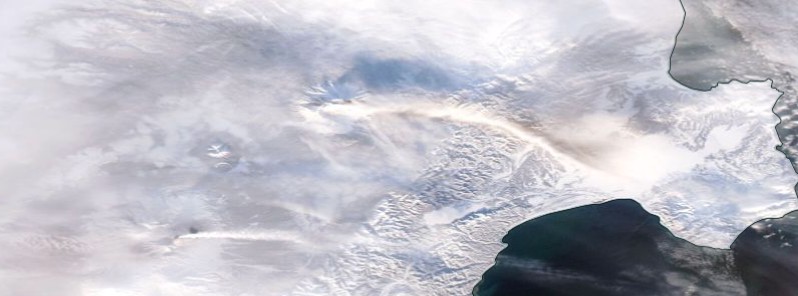Strong eruption at Sheveluch volcano, ash up to 8.5 km (28 000 feet) a.s.l., Russia

A strong eruption took place at Sheveluch volcano, Kamchatka, Russia at 00:35 UTC on December 22, 2020, with volcanic ash rising up to 8.5 km (28 000 feet) above sea level.
As a result, KVERT raised the Aviation Color Code to Red at 01:22 UTC.
According to visual data from Ust-Kamchatsk, explosions sent ash up to 8 km (25 240 feet) a.s.l. and an ash plume extended to the northeast of the volcano to a distance of 42 km (26 miles).
Satellite data showed an ash cloud is drifting about 130 km (81 miles) to the east of the volcano, KVERT said at 02:55 UTC, and lowered the Aviation Color Code back to Orange.
The extrusive eruption of the volcano continues.
Ash explosions up to 10 – 15 km (32 800 – 49 200 feet) a.s.l. could occur at any time. Ongoing activity could affect international and low-flying aircraft.
In a daily update released on December 21, KVERT said the growth of the lava dome at Sheveluch continues, accompanied by a strong fumarolic activity, and an incandescence of the dome blocks.

Image credit: NASA Aqua/MODIS. Acquired December 22, 2020. Annotation: TW
Geological summary
The high, isolated massif of Sheveluch volcano (also spelled Shiveluch) rises above the lowlands NNE of the Kliuchevskaya volcano group.
The 1 300 km3 (311.9 mi3) volcano is one of Kamchatka's largest and most active volcanic structures.
The summit of roughly 65 000-year-old Stary Shiveluch is truncated by a broad 9-km-wide (5.6 miles) late-Pleistocene caldera breached to the south. Many lava domes dot its outer flanks.
The Molodoy Shiveluch lava-dome complex was constructed during the Holocene within the large horseshoe-shaped caldera; Holocene lava dome extrusion also took place on the flanks of Stary Shiveluch.
At least 60 large eruptions have occurred during the Holocene, making it the most vigorous andesitic volcano of the Kuril-Kamchatka arc.
Widespread tephra layers from these eruptions have provided valuable time markers for dating volcanic events in Kamchatka.
Frequent collapses of dome complexes, most recently in 1964, have produced debris avalanches whose deposits cover much of the floor of the breached caldera. (GVP)
Featured image credit: NASA Aqua/MODIS

Commenting rules and guidelines
We value the thoughts and opinions of our readers and welcome healthy discussions on our website. In order to maintain a respectful and positive community, we ask that all commenters follow these rules:
We reserve the right to remove any comments that violate these rules. By commenting on our website, you agree to abide by these guidelines. Thank you for helping to create a positive and welcoming environment for all.